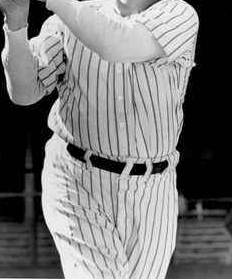The Worst Stolen Base Attempt Ever

The art of base stealing is equal parts mental and physical. Sure, speed is a prerequisite, but knowing when to run- and when not to run- is just as important. Baserunners have to time the pitcher’s motion perfectly, and they also have to know the situation. If a team is losing by a few runs in the late innings, stealing a base won’t help increase the chances of winning too much. On the other hand, getting caught could kill a potential rally.
Let’s play a game. Think of the absolute worst possible time for a stolen base attempt. Try to imagine a scenario so dreadfully bad that getting thrown out would bring a lifetime of shame.
Do you have one in mind?
Ok, now I’ll give you a real life situation that actually happened. I promise it’s way worse than the one you’re thinking of. If I win, you owe me a dollar. If you win, you cheated and I don’t want to play anymore. Deal?
Bottom of the 9th, two outs, down by one…
The man at the plate, who shall be revealed at the end of our story, was the last chance for his team. He’s the only man standing between victory for the visitors and defeat for his fans. The one and only rule is to not make the final out. The batter accomplishes this goal by drawing a walk.
The batter has now become a baserunner. That shouldn’t be a problem; the mission hasn’t changed. In fact, the mission of not making the last out is much, much easier. Except that this particular baserunner has delusions of grandeur. He wants to advance himself into scoring position, and in doing so has forgotten that his one and only job is not to get thrown out.
According to the run expectancy matrix, stealing a base increases the likelihood of tying the game from 21.4% to 30.5%. That’s completely independent of any other variables, such as the players involved, but getting caught means game over. Attempting a steal is clearly a bad play; it’s just not worth the risk. In a much different time period, Earl Weaver once said,
“MAKING OUTS ON THE BASES IS THE WORST. RUN YOURSELF RIGHT OUT OF A FRICKIN’ INNING.”
…In Game 7 of the World Series…
Winning a championship is the ultimate goal. Each regular season game was merely 1/154 (this is your first clue) of a final product- a minuscule blip that rarely factors into a team’s playoff chances. Any given regular season game is so meaningless that it takes sixth months of them to achieve a worthwhile sum.
October baseball is another matter entirely. At this time, there was no Wild Card, Division Series, or Championship Series. The team with the best record in the American League advanced directly to the World Series, where they played their counterpart from the National League. With only four, five, six, or seven games to prove dominance over the opponent, and thereby the entirety of the baseball universe, each game’s magnitude increases exponentially. The seventh and deciding game carries more importance than any other possible baseball game all year.
On any other day, a one run deficit is disappointing, but really no big deal. The ninth inning of a 3-2 game with two outs in Game 7 is as dire a situation as there can possibly be. To draw a walk and rekindle the spark of hope for a championship means everything. To then try to steal second base, is indescribably foolish.
…With a home run champ at bat and a Hall of Famer on deck…
(This section should give away quite a bit of details.)
After our anti-hero drew the walk, Bob Meusel came to the plate. The previous season had been his best, having led the AL with 33 home runs. In the year of our story, he slugged just 12 long balls, but he had missed all of July with an injury. Still, his slash line that season was .315/.373/.470, and his OPS+ was 120. He was unquestionably an excellent hitter who was more than capable of driving in the baserunner, tying the score, and even smacking a walk-off, World Series clinching dinger.
On deck was one of the greatest hitters to ever lift a bat. Lou Gehrig was just 23-years-old at the time, and this was his first full season in the majors. He batted .313/.420/.549 with 83 extra base hits, including a league leading 20 triples. Should Meusel- the winning run- reach base, Gehrig would’ve had the opportunity to drive him in and win the World Series.
…Against an MVP catcher and Hall of Fame pitcher…
Perhaps our baserunner had some kind of scouting report that said to run on the catcher? If so, that scout should’ve been fired immediately. Bob O’Farrell was behind the pate, a veteran catcher enjoying his finest season. Incredibly, he started 142 games that season, and produced excellent results offensively and defensively. That winter, he would win the League Award- a predecessor to the MVP given to the best player in baseball (though repeat winners were not allowed).
Very little of this matters. What does matter is his fire hose of an arm. That season, he gunned down 53 of 104 potential basestealers. Back then, players were far less discerning about stealing bases. Records are shoddy, but attempted steals were successful roughly 55% of the time. Against O’Farrell, less than half made it safely. This was clearly not a catcher to mess with.
On the mound was Pete Alexander, a 39-year-old future Hall of Famer in his 16th major league season. His career bWAR is 117.1, which is the fourth most ever by a pitcher. That season, he limited basestealers to just a 9-19 success rate against him and picked off a runner. The veteran right-hander had thrown more than 4,500 innings, so it’s fair to assume he knew how to hold a runner.
…With a notoriously overweight baserunner…
The most creative baseball minds aren’t pioneering owners or cutting edge management. It’s the people that write players’ listed weights. Our boneheaded main character (have you figured out who it is yet?) was listed at 6’2, 215 lb. Here’s a picture of him from the neck down:
Quite simply, that just doesn’t look like a man who’s anywhere near 215 lb. For a modern comparison, Mike Trout is listed at 6’2, 235 lb.
Back to our mystery baserunner. That season, he stole 11 bases in 20 attempts, which was about league average for the time period, but not nearly good enough to take such a huge situational risk. 20 sounds like a lot by modern standards, but this man reached base 331 times that year and posted a .516 on base percentage. The fact that he only attempted 20 steals in the regular season shows that he knew this wasn’t his greatest strength. He was 31-years-old at the time, and would finish his 22-year-career 123-240 in steal attempts (though there may be some missing records of caught stealing).
Time up!
Did you figure it out? Who was this man who ended the World Series on the absolute dumbest stolen base attempt in history? It’s none other than Babe Ruth! In 1926, he slashed .372/.516/.737 with 47 home runs and 144 walks. Incredibly, this was a pretty pedestrian season for the greatest hitter of all time, and none of these ridiculous numbers were career highs. In the World Series, he did even better. The Cardinals walked him 11 times, leading to a .548 on base percentage. He also added four home runs in the seven game series, and even stole a base off Alexander/O’Farrell in Game 6.
But not in the ninth inning of Game 7. With the Yankees down to their final out of the season, the absolute best batter you could possibly want in that situation delivered with a walk. Then he was thrown out stealing on the first pitch. Meusel and Gehrig never got to swing the bat.
How can anyone possibly overcome such shame? Well, the next year he smashed 60 home runs, leading the Yankees to a 110-44 record, and sweeping the Pirates in the World Series. So that helps.
-Daniel R. Epstein






















